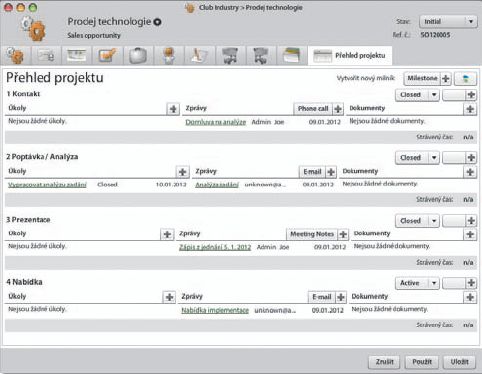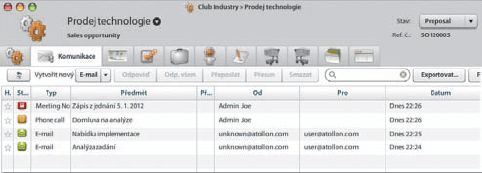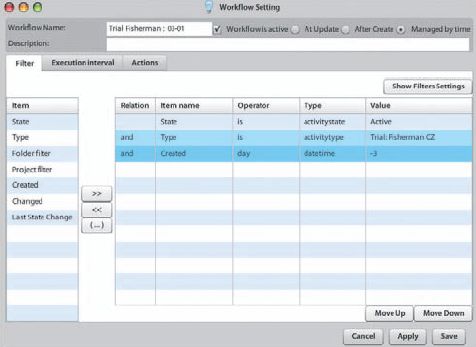How To Win Corporate Customers
The Role of Customer Relationship Management (CRM) in Client Communications
Long-term business arrangements are normally not made based on impulse. From a client’s perspective, they require a structured process that could take anywhere from several days to months.
A key challenge for a company’s management and its Information Technology (IT) Department, is to ensure that the customer has the very best experience possible in all areas dealing with customer/company interaction.
From the initial customer contact with a company — whether via the Web, e-mail, a phone call, or even a social networking site — to the signing of a contract, and into subsequent partnership, the customer must feel that the company is the best possible partner for solving their particular problem, or problems.
The whole process can be simplified into the following phases:
1. The company gains an awareness of a potential problem on the customer’s end.
2. The company approaches the client, offering to help them solve their problem.
3. While looking for a possible solution, the company at the same time considers what alternatives are available.
4. Together, the client and the company devise a contract that takes into consideration the implementation of the decided-upon solution during their negotiations.
5. After this contract negotiation, a contractor and a customer enter into long-term arrangement. This arrangement does not end with the solving of the problem, but continues with additional customer care and subsequent service.
Note: At each stage of client/company contract negotiations, it is possible to use various software tools that potentially make the process of acquiring the customer as a client easier.
Information systems that can help individual company departments:
Marketing
• Generate — Allows companies to reach more potential customers by the implementation of various online, both inbound and outbound, campaigns.
• Analyze — Obtaining detailed customer behavior statistics allows the company to adapt its marketing campaigns to fits the customer’s needs.
• Identify Potential Clients — Determine potential clients that can be immediately passed on to the sales consultants.
Sales
• Individual Care — By tracking all interactions with a customer through their account, you will be able to better anticipate potential opportunities to further help that client in the future.
• Consistency — By standardizing your business processes, meeting deadlines, and keeping your work at the highest level, you can provide a better quality of work all around.
• Motivate — Indicate the level of communication with individual customers, as well as the expected turnover, etc.
Leadership
• Plan — Working with marketing and sales consultants, set up marketing and sales programs, focusing on the objectives of each, both in relation to the acquisition of new customers, as well as in relation to the care of existing clients and additional sales to current customers.
• Evaluate — Keep the statistics of the various marketing campaigns, measuring the successful campaigns against the unsuccessful campaigns of both the marketing and sales departments, keeping an eye on the potential turnover rate for the company as a whole.
• Improvement — Learning from what works and what doesn’t; develop procedures that will lead to better processes, and thus better customer problem solutions.
Implement better CRM, in conjunction with other techniques used for the controlling of procedures, better communication methods, an improved content management system, and the use of social networks to facilitate the function of CRM as a whole, not only to marketers and traders, but also to the whole community. In addition, management must receive this data to make further decisions as to what changes need to be implemented in a timely manner.
The Life Cycle of a Client:
1. Contact
The biggest group of potential customers represents all the various businesses that might find your services useful. Initially, not all your potential customers will realize that they could improve their business model through the use of your products and services. The onus therefore falls on your company to take that first step, reaching out to any potential clients to make them aware of the services you have to offer. The task of marketing, in particular, is to make that initial contact and then develop a rapport between the sales consultant and the client on behalf of your company.
In order to reach more customers, it is imperative that the marketing department organize campaigns aimed for those customers currently outside the company’s current clientele (outbound) or those customers already working with the company (inbound). There are a number of tools for both types of campaigns, with some being mutual to both.
Outbound campaigns are typically supported by CRM systems themselves; they allow direct addressing of potential clients by e-mail, phone (as in call centers), or through social networks. The advantage of outbound campaigns and the use of electronic channels is that it is relatively easy to measure their effect, which helps to accelerate the learning process and the ability to respond faster to the needs of the market.

Figure 1: Automated e-mail campaign. “Thanks to the automated e-mail campaign, sales consultants don’t need to constantly reminding clients and potential clients of the ‘obvious’ benefits of your products.”
Inbound marketing is still a relatively new branch of marketing, but there are already many tools in support of less intrusive forms for addressing a client. Most of them focus on the creation and distribution of quality content (expert studies, analysis, statistics, success stories, advice, and guidance, etc.) distributed via blogs, social networks (Twitter, Facebook, LinkedIn, Google+) and in various forms, such as articles, and electronic or traditional books. The task of marketing in conjunction with the overall marketing plan, as put forward by company management, is to ensure consistent communication to the customer about all the benefits of the product or services being offered through the use of all the communication channels available. In order to solve a customer’s problems and to make a marketing campaign successful, it is important that positive results are obtained through the campaign that resonates with the customer.
2. Awareness of the Need for Change
One of the methods to boost your product and service sales is the promotion of the ideas that are essential to the purpose of the products and services your company has to offer. Your firm, or its representatives, should establish the role of expert in the field the customer is involved in, becoming a source of knowledge to which potential customers will turn to in an effort to leverage your know-how and expertise. Through quality content, it is possible to open the eyes of potential clients, such as revealing how to solve the problem, in part, and how they can achieve long sought-after goals.
Once you have made the potential client realize what you can do for their company, they will realize that you hold the solution to their problems. This is the time for you to directly offer them the solution. This is a critical phase of the process, because you need to offer the solution only when the client recognizes their need, not before. On the other hand, an offer made too late might could be rejected.
Tools for Identifying Customer Interest
Apart from the obvious tools, such as direct telephone contact with the client or through the use of a Web form, there are more sophisticated models for the monitoring of customer trends . Monitoring of your own Website, blogs, Wiki, and other public sources, are easily obtainable information. In cooperation with inbound and outbound campaigns, it is possible by using tools available to analyze the activity of visitors. Based on customer behavior on your Website, sales consultants can identify potential areas of interests and trends. They are also able to contact the customer directly and start a conversation about the purchase of your products or services.
Another tool available is the monitoring of social networks, where you can identify potential customers for your products or services. Based on the key words, the solution enables you to identify, not only any searches for your product or service, but also product categories that your company deals with. When contacting the B2B customers, it is also possible to monitor the amount of possible triggers that can identify potential interest in your services. A typical example is a notification triggered when a potential client expands by hiring new workers, or a new investments notification, or even when a potential client develops new products, and so on.
3. Search for Alternatives and Procurement decisions
The moment a potential client realizes the need for change, they start the process of finding out how to solve their problem and with whom to solve it. If you have already entered into a constructive conversation prior to this phase, you will be at the top of the list of the potential contractors. If the client already knows about the need for a solution to their problems, and you start negotiations on how to solve their problem, or problems, you are starting a new phase in your relationship with the client. This phase should, without a doubt, affirm that your offer is the best alternative to them.
How to Win a Contract Against the Competition
An individual approach to a client’s needs is an important aspect of the competition for a B2B client. In order for your sales consultants to deal with the specific needs of a client, present both obvious and unseen benefits. And while apparent benefits eventually become self-evident, it is still critical that the sales consultant adequately emphasize both basic and outside-the-box benefits in a presentation to the client. Not emphasizing all benefits can cause a contract to fall through. It is therefore appropriate to establish supporting data of each product or service, as well as to present all the obvious benefits in order to promote that product or service to a potential client.
The best CRM systems offer process functionality when developing a solution to the client’s problem. The automated care of a potential client should be a major part of this process; present seamless solutions to the potential client. This care can be started after the client’s indicated interest in the offered solution; you can begin by sending a series of e-mail articles or suggestions, for example.
The Life Cycle of a Business Case
Once you have identified the client’s interest about a specific product or service (hereinafter referred to as the solution), it is time to intensify activities aimed at obtaining the client and a subsequent contract. The aim is to keep constant contact with the client and not let any opportunities pass you by. High-quality CRM systems take care of everything.

Figure 2: Phase of the business case. “It is good to present the firm’s ‘best’ in every stage of the business case. Therefore, it is necessary to nurture each stage individually.”
The CRM in Support of the Business Case
Each business case has a structure involving phases that need to be individually overseen. Some stages require direct participation of a sales consultant, and some activities can be automated within an active CRM system. The course, and timely resolution, of the business case is highly dependent on the diligence of your company’s services or products. A good CRM system allows you to adjust the course of the resolution business case, depending on the action required, utilizing your products and services. Typical phases of the business case include:
• Contact — You load a business case into a CRM system. You got a tip on a client, so you know that the client might have an interest in your solution. In this phase, you identify key people on the client side who will affect the decision to accept your offer or not. In relation to the business case, you make your CRM system look like the best option to those people.
• Demand/Analysis — Find out what a client is interested in and what their needs are and then suggest how to satisfy these needs. Do this by preparing a presentation for them. The CRM system should record the activity associated with a client presentation on the sales calendar. This will be one of the sources for subsequent evaluation of the sales consultant’s abilities and expertise.
• Presentation — Present a solution to the client, asking further questions as they arise. The CRM system will handle the promotion of the selected solution.
• Offer — Create and send an offer to a client and then wait for their initial feedback. The CRM system ensures that you will not forget to call the client about the offer and its acceptance or nonacceptance.
• Contract — Send a contract draft to the client. This draft establishes an electronic paper trail of the activities associated with the business case in the form of an e-mail message. The CRM system ensures that you will check the delivery of the draft and motivate a sales consultant to validate the delivery by phone.
• Triumph — After signing a contract, the CRM system ensures the transfer of the contract into a physical form, or at least asks the sales consultant for the identification of those responsible for your business, which will further ensure coordination of the contract. The person responsible revises, inputs, and sends any other information and instructions to your client as soon as possible. Everything is recorded in the CRM.
• Failure — If for some reason the terms of the contract are not accepted, send a thank you message for any existing cooperation and propose to the client to stay in touch. The CRM system ensures the half-automation of this step, again so you will not forget it.
• Deferred — Or, as is sometimes the case, the business case is postponed because it is no longer a priority for the client. However, in order to increase your future chances, the CRM system automatically ensures that you stay in touch with a potential client through further promotion, or returns the activity to the stage of awareness as the client’s needs change.

Figure 3: Business case communication. “A CRM system holds memories of actions. It will help you if you need to return to any point of a business meeting.”
Individual Approach to a Client
It is very important to pursue the solutions to problems that the customer considers as priorities. The message must always be simple, valuable, and in accordance with the customer expectations. It is necessary to monitor the interactions with a client directly in the CRM in order to retain all of the knowledge as the property of the company, due to your sales consultant’s dedication to clients in the long term. Recording activity should not be of too much concern to your sales consultants. The task of the CRM system is to monitor all communication, meetings, sent documents, and interactions on social networks, and so on.
The Involvement of Reference Customers
A suitable method for obtaining new customers is also the involvement of existing clients as a reference. If a reference visit is a possibility to key customers, or a telephone consultation with an existing client becomes available, then use it. It is one of the best ways to overcome initial doubts about your credibility. With good references from existing customers, you overcome large a number of obstacles very quickly. A good CRM system, which is integrated into your company Website presentation, can support the expansion of your client portfolio through tools that actively recommend your company. You can also regularly reinforce references through a wider participation of reference customers in social network discussions about your solutions, recommendations, or reviews of your solutions.
Automation of a Business Workflow
Any activity with business model maturity that becomes a routine process should be automated. Only then it is possible to grow and scale your business model. The role of the CRM should be to maintain the important business cases in the mind of a sales consultant; a promotional campaign should provide automatic reconciliation of a client’s knowledge about the offered solutions, and, most importantly, management should be informed when key procurements are not going smoothly.

Figure 4: Setting the time workflow. “A system should implement routine activities. Thus, sales consultants can focus on increasing the value of the services and product perceived by a customer.”
A quality CRM system should allow a rapid and easy involvement of third parties in the business process, including the ability to monitor the progress of the implementation of the business case by a client, which is best done online.
